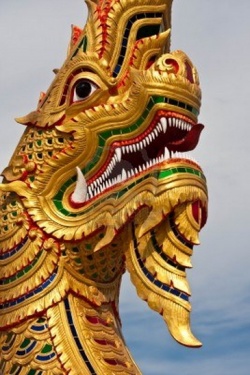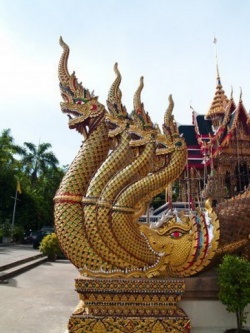Naga legends
Universal In myths, legends, scripture and folklore, the category Naga comprises all kinds of serpentine beings. Under this rubric are snakes, usually of the python kind (despite the fact that Naga is usually taken literally to refer to a cobra,) deities of the primal ocean and of mountain springs; also spirits of Earth and the realm beneath it, and finally, Dragons. Many examples of Nagas appear on the walls and along an avenue leading to the temple of Ankhor Wat in Kampuchea (formerly, Cambodia) and also in Buddhist temples in Sri Lanka (formerly, Ceylon.)
In Mexico, we find the "Naga" which becomes "Nagal." In China, the Naga is given the Form of the Dragon and has a direct association with the Emperor and is known as the "Son of Heaven"...while in Egypt the same association is termed "King-Initiate". The Chinese are even said to have originated with the Serpent demi-gods and even to speak their Language, Naga-Krita. For a place that has no serpents, Tibet, they are still known in a symbolic sense and are called Lu. Nagarjuna called in Tibetan, Lu-trub.In the Western traditions we find the same ubiquity for the Naga, or Serpent. One simple example is the Ancient Greek Goddess, Athena. She is known as a warrior Goddess as well as the Goddess of Wisdom; her Symbol being the Serpent as displayed on her personal shield. Of course, in Genesis the Serpent is a Naga who instructs the new infant (humanity) in what is called the Knowledge of Good and Evil. The Christian church has, unfortunately transformed the Initiate-Teacher into a tempting and negative demon-character. An apocryphal tradition says that Apollonius of Tyana, while on a visit to India, was taught by the "Nagas" of Kashmir. (See The Life of Apollonius, by Philostratos.) It is felt by many scholars of the Western Tradition that the Life of Apollonius was taken from the New Testament, or that the narratives of the New Testament have been taken from the Life of Apollonius. This is felt because of ! the undisputed and clear similarities of construction fo that particular narrative.
In Indian mythology, Nagas are considered as a subterranean race of primarily serpent-beings living under the sea in a place called Patala which is believed to be the seventh of the "nether" dimensions or realms. They are children of Kashyapa and Kadru. Varuna, the Vedic God of storms, is viewed as the King of the Nagas, ie. Nagarajah. The Nagas are the enemies of the Garudas, divine eagle-like creatures. Some argue that the myth reflect the conflict between Aryans and indigenes (Vishnu's mount, a solar Symbol clutching the Naga in his claws).
In the Language of Kashmir, the word for "a spring" is Naga and, in fact, Nagas are considered the earliest inhabitants of that region. The Nilamatapurana listed 527 Nagas that were worshipped in Kashmir. In the account of Abul Fazal, the court historian of Akbar, there are references to seven hundred places sacred to serpents. A large number of temples were built near springs and were dedicated to the worship of Nagas. These places have become great centres of religious Pilgrimage. The Rajatarangini of Kalhana mentions Sushravas and Padma Nagas, who were tutelary deities connected with the Wular lake. The Dikpalas of Kashmir are believed to be four Nagas, viz. Bindusara in the east, Srimadaka in the south, Elapatra in the west and Uttarmansa in the north.
Nagas remain associated with water and springs for every inhabitant of Kashmir wether Hindu or Muslims (now the majority). In the Anantnag district, people offer sacrifices to the Vasuk[i] Naga during days of water scarcity or extra rainfall, (the water of which remains in the valley during summer only and disappears in winter) They have full Faith that offerings to Vasuk will bring rain or stop it as desired. A person Suffering from a skin disease is said to be cured after having a bath in Gandhakanaga (sulphur spring) at Naghbal, Anantnag.
Many Kashmiri festivals relate to Naga worship, for example during the first snowfall, Nila, the Lord of Nagas, is worshipped. The Nagas are also propitiated in April and are related to Iramanjari Puja and to Varuna Panchmi, which is organised in July-August." And "in the darker half of the month of Jyeshtha, when a big festival is organised to propitiate the king Taksakyatra.
Udyana, in modern Pakistan, was famous for its water Dragons. This is a story of one of those Dragons.
It was by his subtle but powerful charms that the Naga Apalala was able to keep the wicked Dragons in check. He prevented them from scourging the countryside with violent rainstorms. Asian Dragons are quite often associated with the Life-giving waters. Thanks to the Naga Apalala this countryside prospered and the grain grew thickly. In Gratitude each family offered him a bit of grain as tribute. After some time several of the inhabitants of the place began to forego the yearly Offering. The Naga became angry and prayed that he might become a poisonous dragon so that he could drench the countryside in rain and wind. So it is that at the end of his Life he became the dragon of that country. To this day Rajas (local princes) in the Hindu Kush are said to be able to control the elements as their influence over local Dragons provides.
In a Cambodian legend, the Naga were a reptilian race of beings who possessed a large empire or kingdom in the Pacific Ocean region. The Naga King's daughter married the king of Ancient Cambodia, and thus gave rise to the Cambodian people. This is why, still, today, Cambodians say that they are "Born from the Naga". The Seven-Headed Naga serpents depicted as statues on Cambodian temples, such as Angkor Wat, apparently represent the 7 races within Naga society, which has a mythological, or symbolic, association with "the seven colours of the rainbow". Furthermore, Cambodian Naga possess numerological symbolism in the number of their heads. Odd-headed Naga symbolise the Male Energy, Infinity, Timelessness, and Immortality. This is because, numerologically, all odd numbers come from One (1). Even-headed Naga are said to be "Female, representing Physicality, Mortality, Temporality, and the Earth."
Legends similar to the Cambodian legend exist amongst the tribal Hindus of Southern India (Adivasis) and the aboriginals of Australia. In this version of the legend, the Nagas inhabited a massive continent that existed somewhere in the Pacific Ocean region. The continent sank and the remnants formed the Indonesian archipelago and Australia. These Nagas are said to have developed a subterranean or underwater civilization technologically more advanced than ours and they are Thought to possess superhuman powers.
Nagas in the Indian State of Nagaland
In addition to the Cambodians there exists a significant ethnic group of South East Asian extraction native to India's North-East known as the "Naga". They live in the Indian State of "Nagaland" (named after their tribe) and have traditionally believed that they are the direct descendants of the mythological "Nagas". Due to Christian missionary activity, many Nagas of Nagaland have lost most of their tribal lore including the legend of their origins as descendants of supernatural snake beings. References to the existence Nagaland Naga tribals and their traditional beliefs have been recorded in the ancient Indian Hindu Books of Knowledge known as the Vedas.
Nagarjuna is one of the main champions of Buddhist Philosophy, and is traditionally portrayed with a sunshade or Halo formed by a multi-headed serpent. He is called the Second Buddha, partly in tribute to his having established the Madhyamaka (Middle-Way), ie. neither materialist nor nihilist nor idealist] school of philosophy. In the symbolism of Himalayan Buddhism and in Tibetan mythology, Nagarjuna is known as Lu-trub.
The tradition of Sera Monastery holds that when Sakya Yeshe was on his way back from visiting China, it so happened that the set of Tengyur (Buddhist scriptures) donated by the emperor fell into the water while the party was fording a river. The travellers could see that the texts were hopelessly lost and so, distraught, they continued on their way back to Sera.
When the caravan finally got back, the Monks told them that just before their return, an old man with attendants had visited Sera and presented a set of scriptures to the Monastery. He said that he was delivering it for Sakya Yeshe. It was believed that the old man was really a Naga king, for when the texts were examined, it was found that they were still a bit damp.
The traditional Life-story (Tibetan: namthar) of Niguma, the female companion of Naropa, begins during the time of one of the earliest Buddhas in a region covered by water ruled by a great Naga King. This Naga was an accomplished and compassionate Disciple of that Buddha and gave his permission for the miraculous drying up the water for the purpose of erecting a great temple and Monastery. A bustling city grew up around these which acquired a certain reputation, and came to be called The Land of Great Magic. This is the place that Niguma was born.
Niguma developed the powerful tantric techniques referred to as the Five Dharmas of Niguma. The best known is called the Dream yoga of Niguma. Her Disciple, Naljor, is considered the head of the Shangpa Kagyu denomination of Tibetan Buddhism.


